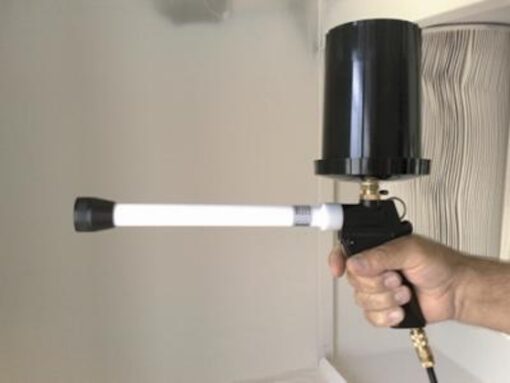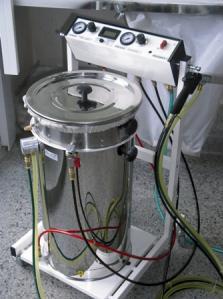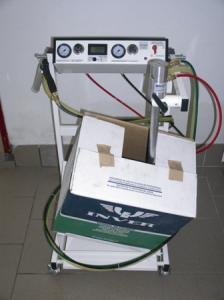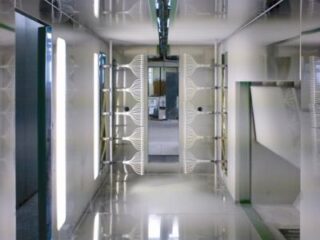We associate the word powdering with the activity of dispersing finely ground solids. In agriculture, for example, it is fertilizer, in the food industry sugar, in foundries a metal separator and moulds.
In many fields of human activity and in many technologies, we need to spread a powder mass evenly over a specific area or to disperse it evenly over a specific volume. About fifty years ago, someone had the idea that if it were possible to apply a synthetic material, for example paint, to industrial products while still dry, without solvents, then not only would solvents and thinners be saved, but also the environment. However, we still have to pay a price elsewhere.

Fig.1: Prsten 031 handheld tribo spray gun.
Fig.1: Ring 031 manual spray gun. It is a simple manual spraying set for spraying powder materials with frequent changes of the range and colour shade. The paint is fed from the Z1RH carrier one-litre tank.
Saving solvents and improving the working environment
Over the last forty years, powder coating technology has carved out a distinctive position among organic surface protection products. What are its advantages? The already mentioned savings in solvents and a better working environment, as well as the savings in time and space, as we achieve the necessary coating thickness even with a single layer application. The disadvantages include the fact that the material of the treated goods must withstand the curing or pouring temperature of the protective substance, that the size of the products is limited by size and weight, and the repair of the built-in part is complicated.
The actual application of the powder is carried out in facilities and areas that allow the capture of the fly powder fraction so that the hygiene of the work meets the prescribed standards and so that the uncaptured powder can be reused on the goods if necessary. This leaves only the question of how to apply the powder to the object. On horizontal surfaces, we can get by with sprinkling; on inclined and vertical surfaces, we must “trap” the powder particles on the surface of the object for the necessary transport time to the casting or curing oven. To do this, we either preheat the surface and the powder particle will “heat stick” to the surface, or we add an electrical charge to the particle which causes the particle to be held on the conductive grounded surface by electrical forces. The technology of applying the powder “hot” or to a pre-heated surface to be treated is operated either by sprinkling (spraying) or by immersion in a container of powder.

Fig.2: Progress 1ZP manual spraying tribo set.
Fig.2: Progress 1ZP manual spraying tribo set. The set consists of a manual gun Prsten 03 with a C4F powder pump pumping from a 30 litre ZP30N powder reservoir refilled via a PPP3 pneumatic powder sifter. The set is mounted on a transport trolley with a control and control cabinet, which includes a tester for electrical properties of powders, grounding of sprayed objects and wear of charging parts of the gun. Suitable for workplaces with a steady range of goods and a lower number of colours.
Spraying in an electric field
Among the most widely used powder technologies in surface treatment is electric field spraying. Compared to the above mentioned, its advantages are undeniable in that this technology achieves a uniform coating even with small thicknesses, and in relation to immersion it is easy and cheap to change the type of powder or colour shade. This technology is limited by the electrical capability of the powder particle material itself. Good organic insulators that can be finely ground are most suitable. If conductive (metallic) powder particles are also to be coated, then it is also necessary to coat them with a suitable insulator.
The secret of the principle of particle retention on a conductive or semiconductive surface is that the electrical charge acquired in the application technique is retained by the dust particle for a long time even after it has landed on the grounded sprayed object. Thus, it is possible to treat metal, glass, ceramic and all objects that can withstand the curing temperature of the powder without change. It is a good idea to consult experts whenever spraying or applying organic or inorganic powders.

Fig.3: Progress 1AK manual spraying tribo set.
Fig.3: Progress 1AK manual spraying tribo set. The set consists of a manual gun Prsten 03 with a pumping device Krtek 3, which allows pumping powder directly from a transport package, for example a box, which is placed on a scythe bench Aron1. The set is placed on a transport trolley with a control and control box, which includes a Tester of electrical properties of powders, grounding of sprayed objects and wear of charging parts of the gun. The kit is suitable for more frequent colour changes.
Two basic principles of electrostatic charge generation are used to electrify the deposited powder particles. The natural principle relies on the triboeffect, i.e. the separation or friction of two insulators, to form positively charged particles. The second principle, coronal, is based on the passage of a dust particle through a high intensity electric field where it acquires a negative charge. The resulting coating and its properties depend on the powder material used, the application technique employed and the quality of the surface treatment prior to actual application.
Efficiency of powder spraying
The cost-effectiveness of powder spraying has several basic parameters – cost of human labour, energy consumption, consumption of spraying material and chemicals. These are the three influential parameters given the same production base. Behind all of them, one has to see a specific human being. Human labour is the most valuable of all as it influences the other two parameters the most. Consistently, diligence at work, constant maintenance and cleaning of equipment, adherence to the technological parameters of pretreatment, shear and cure, inspection and handling of goods are areas that translate into rejects, energy leakage, unnecessary overspray and unrequired thicknesses. Waste in general. It is good to keep in mind that the efficiency of the actual spraying process is dependent on the balance between the power of the spraying equipment, the charge generated and the intensity of deposition in the spray area.

Fig.4: Mechanised spraying tribo workstation 14.
Fig.4: Mechanised spraying tribo workstation 14.The workstation is an example of the company’s recommended concept of spraying goods with powder paints when the goods to be treated are suspended on a continuous conveyor. On both sides of the conveyor, the Ring 03A automatic spray guns form spray walls, each section of which can be instantly shut down according to the needs and height of the passing or hanging goods. The operator’s operability and adaptability to the irregularity of the goods is a considerable advantage over spraying with motion manipulators. The number of sections is selectable according to the height to be sprayed and the suction capabilities of the cab. Each gun is powered by a C4F pump. Control of a single spray wall or complete spraying station is concentrated in the KRM control and regulation module cabinet. The line shown in the picture uses 12 automatic guns + 2 manual guns for pre-spray or spraying.
Spraying equipment for powders, especially powder paints, are represented on the Czech market by the offer of many world companies. Domestic spraying equipment based on the triboeffect principle belongs to the technical world top, while the prices are significantly more advantageous. Spraying machines are manufactured and delivered in manual and automatic versions, with all necessary accessories, such as special adapters for cavities as small as 14 mm in diameter and up to depths of 1,500 mm, special shaping nozzles. Manual guns benefit from the possibility of spraying from three types of carried canisters for frequent colour changes or five sizes of staggered canisters when spraying one shade for a long time. With a handgun designed in this way, pumping powder from a deferred reservoir eliminates the weight of the paint can itself and opens up the possibility of spraying guns in all spatial directions.
Branched Nozzles
Mechanised or semi-automatic powder spraying lines use mainly branched sprayers, which, although immobile, allow perfect coverage of objects with paint. They are used to construct complete spray walls, each part of which can be easily disengaged due to the size of the goods passing through. The advantage of spray walls over spray guns on manipulators will be appreciated by customers with deep and shapely goods. This arrangement is also very economical in terms of paint consumption, energy consumption and wear and tear on the loading parts of the guns. All mechanized system controls are pneumatic (hence explosion proof), simple and trouble free.
The Jevan Ledeč nad Sázavou company, which supplies these spraying units, also offers special leakage resistance meters for workplaces threatened by electrostatic discharges or devices for proportional measurement of electrical properties of powders. It represents a research and development facility for powder coating of all types with more than 30 years of experience. It also provides free consultancy for start-up companies or solves problems of established companies with this coating technology.
Ing. Josef Ježek
Published in MM Průmyslové spektrum: 2011/04
